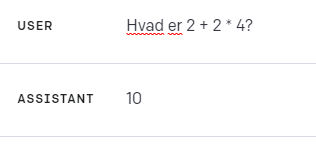Although AI has been the subject of much attention and interest, there are still many who don't quite know what AI actually is and how it functions. In this blog post, we take a step back and answer what AI really is and how it works.
How does AI work? Is there anything we should be concerned about? These are questions many people are asking in these times, where AI is advancing and being used in various industries. And now, we attempt to answer the many questions and confirm or refute some of the many concerns and excitements that come with it
How does AI work?
Many have already heard about ChatGPT and how the technology can be used to write all sorts of texts from poems to stories to SEO texts to entire articles. It can even write code for websites and applications.
It may seem completely insane, but how does it actually work at a basic level?
ChatGPT and many other AIs are what is called a "large language model" (LLM). It is a model built on millions of texts, books, articles, forums, tweets, etc. Without delving too deeply, one builds a statistical model based on all of these texts that can predict the next words or tokens, as they are called in the AI/LLM world.
It can be compared to when you talk to someone you know so well that you can finish each other's sentences. Similarly, these models/AIs can predict the next words based on what you write to them in the text box.
Now you may be thinking, "But when I write the exact same text, it doesn't always give the same result, how can that be?
And that's a good question. The answer is that in the settings behind the scenes, you can tell it how random the next words should be. If these settings are set to be non-random, it will always give almost the same result - just like statistics is not always 100%. You can change this under 'Playground' in ChatGPT under 'Temperature', which defines the randomness:

Here are 2 examples where I ask the technology to do the following "Write a short text about vanilla ice cream" with as little randomness as possible:
|
Example 1: Example 2: |
As you can see, the 2 examples are the same, but if I introduce randomness, you will get 2 completely different results:
|
Example 3: Example 4: |
Although I asked the technology to write about the same thing, but with randomness, I got two completely different results.
The same goes for other AIs, not only text, but also AIs that can create images and videos. There are certain things to be aware of when using AI. And you should exercise the same caution when asking such AI to write/do math. Just look at the examples below:

Okay so far so good, but what if we do this:

Wait, what, that is not 10?
As you can see, math is difficult for technology. And therefore, you must be extra careful and use technology for mathematical challenges with caution.
However, it is worth noting that the latest version of ChatGPT can be combined with WolframAlpha, which is an answer engine designed to answer factual and mathematical questions, making it possible for ChatGPT to do math.
So what is the conclusion?
The conclusion must be that AI is a wonderful technology that can solve complex problems, but it is important to remember that it is necessary to have a deep understanding of how the technology works and how it can affect the results. Even small adjustments to the settings can lead to significant differences in the output, and therefore it is crucial to be cautious about blindly relying on AI, especially when it comes to mathematical questions, where precision is critical
Should I Fear my Job?
It is perhaps the most well-known concern that AI brings with it. And the short answer is: No, but your job may change, as you now have a new tool in your toolbox.
For example, if you work as a copywriter or content specialist and write texts such as articles, blog posts, product descriptions, and SEO texts, you can use a tool like ChatGPT for inspiration. The technology can be used to tackle text tasks, and the technology's results can spawn new ideas that are valuable in your work. You can also have AI write all or parts of texts in a certain way, and suddenly you are more of an editor than a writer. However, you still need to be critical of the output the technology comes up with - and not just blindly rely on it.
Here is an example of an article where we ask AI to perform a specific task.
Prompt: "You are an expert in AI and a journalist. Write an article about AI and its future impact. Write the article in a professional tone. There should be 3 paragraphs with a corresponding headline."
Result from ChatGPT:
|
Article: AI - The gamechanger of the future Focus of the article: Paragraph 1: AI in the healthcare sector Paragraph 2: AI in the transportation sector Paragraph 3: AI in journalism and media Conclusion In the future, AI technology will continue to challenge our existing understanding of what is possible. Therefore, it is important that we continue to research and develop AI technology with the aim of improving our lives and the world around us |
The result shows that the technology can quickly piece together an article that sounds good. However, there are no sources or source criticism, so it is up to you to ensure that. As you can also read, the technology writes how it can also be used for translations, which it actually performs very well. Try it yourself with this prompt: "Translate the following text into <language>: <text you want to translate>". On chat.openai.com, you can explore the technology, ask it to write something specific, ask questions, or have it translate. It's free to use. But remember that these text AIs do not perform mathematics and factual data for correctness.
So, in different ways, the technology can be a valuable tool for you as a writer to use. So, in other words: you should not fear for your job right now, but you should be prepared to use AI as a new tool to produce more and be more efficient.
The next question is: How can AI be used in other genres than just text and translations?
AI for Various Purposes: Code, Image, Video, and Subtitles
As previously described, these LLM AIs can also be used for more than just text production. Let's take a look at some of them below:
AI for code
AI can also be used for another form of text, namely to code for us. However, one should also be careful and inspect the codes thoroughly. But since LLM AIs can code, the technology can be combined with code tools such as Github's co-pilot and Amazon's CodeWhisperer.
With these directly connected to their code tool, it suggests code to write. It can be compared to pair-programming with a junior programmer, but these will only get better with time and may eventually write much of what we call boilerplate code.
Github's co-pilot is also soon to be in trend, as the tool comes with a chat function where one can chat with the code and ask questions. A feature that will undoubtedly make it easier to find functions in the code and how they work.
AI for image production
There are also AIs for more than just text production. AI can also be used to generate images using tools such as Midjourney, Stable Diffusion, DALL-E, etc. These AIs each have their own strengths and weaknesses.
To explain it further, here's an example with the same prompt from two of these different AI image generators. I enter the following prompt in the systems: "A monkey on the moon dancing on a skateboard wearing a high hat."
The result with Stable Diffusion

The result with DALL-E

As can be seen, it gave two widely different results. However, they are both relatively easy to spot as AI-generated. The technology is still new, and it's getting better, and soon we won't be able to tell that a computer has generated images like these.
AI for video and subtitles
Several people also have AIs that can generate text from a video, that is, what is being said in a video, and thus quickly produce subtitles. And these subtitles can even be quickly translated, as previously described, it is one of AI's strengths.
Bonus info: You can also clone your voice with AI and use that voice to make it say what you write to that AI, see e.g. Elvenlabs and Bark
What Smart AI Tools Can you Use Today?
Hopefully, the blog post has answered many questions related to AI, and perhaps you have had some of your concerns or excitement about the use of this revolutionary technology confirmed or refuted.
If AI is still a completely new world of colors for you, we have put together a list of AI technologies and combinations that you can already get to know better today:
- ChatGPT: ChatGPT is a large language tool that can be used to generate language and answer questions based on the context presented. It can also be used to perform tasks such as translation, text generation, text classification, and much more.
- ChatGPT + plugins: This requires ChatGPT Plus membership and that you are lucky enough to get plugin access. But here you can do anything.
- Bing AI: Same function as ChatGPT but with internet search.
- Bard: Googles AI search engine, which is very similar to Bing AI.
- Perplexity.ai: An alternative search engine to the two above.
- Midjourney: Image generation.
- Stable Diffusion: This is an open-source solution for image generation that you can host yourself.
- DALL-E: OpenAI's image generation.
- ControlNet: This is a tool for controlling diffusion AIs like Stable Diffusion. This means that you can create a certian style that stable diffusion will adhere to. See this video, which shows how the technique creates an anime.
- Auto-GPT: Can be self-hosted and tried here. This uses OpenAI's ChatGPT AI models to generate small tasks based on the task you give it. Then it researches how to perform these tasks and uses this information to perform the next task, which may be to write some code and execute that code. The technology is impressive in itself and contains a lot of potential.
- Runway Gen-2: This AI can create video from text.
- Elevenlabs: Clone a voice, write text for the cloned voice, and hear the result.
- Bark AI: A self-hosted open-source version of what Elevenlabs can do.
- Segment-anything AI: AI made by Meta to easily and quickly segment elements in an image and tell what is in the image and what the different segments are.
- Whisper AI: Converts speech from a video or audio clip to text.
- Canva Magic: Many are already familiar with Canva, but now they also have an AI to visualize your designs based on text.
- Adobe Firefly: Adobe's AI for designing and generating images.
- FileGPT: You can now chat with your PDFs, documents, websites, etc.
This is just a selection from the list of AI technologies. The list is long and will only continue to grow as AI tools are constantly being developed and improved
How MCB uses AI
AI in MCB.Cloud
At MCB, we have also embraced AI. We have implemented AI into our own platform, MCB.Cloud, and it is now available to all MCB.Cloud customers.
In MCB.Cloud, you can find the function everywhere you see this dropdown and button:

By clicking the "Generate" button, the technology generates appropriate text in the field. You can also choose the tone of the text, and the technology will generate text based on your guidelines.
The button is available on all SEO texts, product descriptions, product group descriptions, course texts, and much more. In fact, you can even generate a whole article from a few keywords and phrases.
At MCB, we are constantly working to improve AI in MCB.Cloud, and you can even follow the development, see what's in the pipeline, and provide feedback and suggestions for the feature here.
AI i MCB’s marketingafdeling
At MCB, the marketing department has embraced AI. In a marketing context, AI can be used to deliver more effective campaigns and better results to customers. AI technology enables the analysis of large amounts of data and provides in-depth insights into target groups and their behavior.
Our marketing team uses AI to analyze search terms and trends to identify keywords that are relevant to our customers and to adjust content and meta tags accordingly. Additionally, AI is useful for optimizing content. By using AI technology to analyze data on user behavior and preferences, we can create and distribute content that is more effective and tailored to our target groups
AI technology is an important and exciting development that will have a significant impact on our future society and economy. Although some fear that AI will replace their jobs, experience shows that it can instead help automate routine tasks and free up time for more creative and strategic tasks. You can use AI for a variety of purposes, such as marketing, video, text production, code, and image generation. But while AI is exciting, one must also be aware of its limitations and potential risks.








